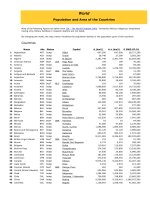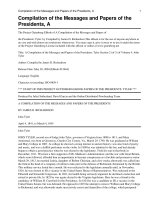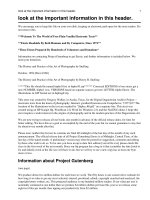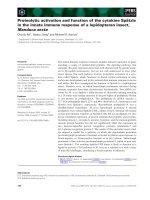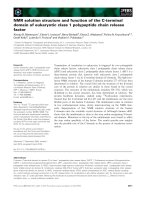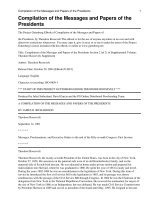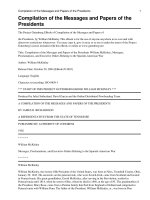Regulation and function of the novel candidate tumor suppressor gene dlec1 in the HCT116 colorectal cancer cell line
Bạn đang xem bản rút gọn của tài liệu. Xem và tải ngay bản đầy đủ của tài liệu tại đây (1.45 MB, 75 trang )
REGULATION AND FUNCTION
OF THE NOVEL CANDIDATE
TUMOR SUPPRESOR GENE
DLEC1 IN THE HCT116
COLORECTAL CANCER CELL
LINE
YUN TONG
(B.Sc. (Hons), NUS)
A THESIS SUBMITTED FOR THE
DEGREE OF MASTER OF SCIENCE
(MSC)
DEPARTMENT OF PHYSIOLOGY
YONG LOO LIN SCHOOL OF MEDICINE
NATIONAL UNIVERSITY OF SINGAPORE
2009
ACKNOWLEDGMENTS
First and foremost, I would like to express my deepest respect and gratitude to
my supervisor, Associate Professor Hooi Shing Chuan, for his valuable guidance,
advice and persistent support throughout the course of the research. I am grateful for
being given such a good research opportunity and wonderful experience.
I would also like to thank my mentor, Qiu Guohua, for his patient guidance and
stimulating discussions.
Thanks also to Professor Bert Vogelstein from Johns Hopkins University for
providing us with HCT116 p53KO cell line.
My heartfelt gratitude also goes to members of the lab, namely April, Baohua,
Carol, Chin Nie, Colyn, Guodong, Puei Nam, Tamil, Wen Chun, Xiaojin,Yuhong
(in alphabetical order) for their friendship, helpful discussions, suggestions and
encouragement. I would also like to extend my thanks to the staffs and students in the
Department of Physiology for their assistance.
Last but not least, I would like to thank my family, especially my parents and
my husband, as well as my friends for their love and support throughout my stay in
Singapore.
TABLE OF CONTENTS
TABLE OF CONTENTS
ACKNOWLEDGMENTS ............................................................................................ i
TABLE OF CONTENTS ............................................................................................ii
LIST OF FIGURES ...................................................................................................vii
LIST OF TABLES ...................................................................................................... ix
LIST OF ABBREVIATIONS ..................................................................................... x
1
ABSTRACT .......................................................................................................... 1
2
INTRODUCTION ................................................................................................ 3
2.1
Cancer.............................................................................................................. 3
2.2
Colorectal carcinoma....................................................................................... 3
2.2.1
Etiologies of colorectal carcinoma........................................................... 4
2.2.2
Genetics of colorectal carcinoma ............................................................. 4
2.3
Tumor Suppressor Genes (TSGs) ................................................................... 5
2.3.1
Identified TSGs in Colorectal Carcinoma................................................ 6
2.4
Oncogenes ....................................................................................................... 7
2.5
Epigenetic Gene Regulation ............................................................................ 8
2.5.1
Hypomethylation and hypermethylation.................................................. 8
2.5.2
Histone Deacetylation .............................................................................. 9
2.6
Approaches in CRC treatment......................................................................... 9
2.7
Growth Signaling Pathways as therapeutic targets of colorectal cancer ....... 10
ii
TABLE OF CONTENTS
2.7.1
PI3K-AKT-mTOR pathway................................................................... 10
2.7.2
Ras-Raf-MEK-ERK pathway ................................................................ 11
2.8
U0126 and MEK inhibitors ........................................................................... 12
3
AIMS OF THE PRESENT STUDY .................................................................. 14
4
MATERIALS AND METHODS ....................................................................... 15
4.1
Cells lines and cell culture ............................................................................ 15
4.2
Drug treatment............................................................................................... 15
4.3
Transfection ................................................................................................... 15
4.4
DLEC1 Knockdown ...................................................................................... 16
4.5
RNA extraction ............................................................................................. 16
4.6
Reverse transcription ..................................................................................... 17
4.7
Conventional Polymerase Chain Reaction (PCR) ......................................... 17
4.8
Real-time Quantitative PCR .......................................................................... 18
4.9
Cell proliferation assays ................................................................................ 19
4.10 Colony formation assay ................................................................................. 19
4.11 Flow cytomery............................................................................................... 20
4.12 Protein Extraction and Quantification ........................................................... 20
4.13 Immunoblotting Analysis ............................................................................. 21
4.14 RNA samples from patients .......................................................................... 21
4.15 Statistical analysis ......................................................................................... 21
5
RESULTS ............................................................................................................ 23
iii
TABLE OF CONTENTS
5.1
Function of DLEC1 ....................................................................................... 23
5.1.1
DLEC1 was down-regulated in patient tumor samples ......................... 23
5.1.2
DLEC1 transient over-expression inhibited cell growth ....................... 23
5.1.3
Reduced colony formation by DLEC1 over-expression in HCT116 cell
line
25
5.1.4
DLEC1 over-expression induced G1 arrest in HCT116 cell line .......... 26
5.1.5
Transient knockdown of DLEC1 in HCT116 cell line .......................... 28
5.1.6
Knocking down of DLEC1 caused significant increase in apoptotic cells
28
5.1.7
Localization of DLEC1 .......................................................................... 29
5.1.8
Re-localization of DLEC1 into the nucleus by Gal4 tag and the effect of
re-localization on colony formation ..................................................................... 30
5.1.9
The level of transcription factor AP2α2 increased with DLEC1
expression level .................................................................................................... 32
5.2
Regulation of DLEC1.................................................................................... 33
5.2.1
Emodin up-regulated the expression of DLEC1 in a dose-dependent
manner in HCT116 cell line ................................................................................. 33
5.2.2
ERK and PI3K inhibitor stimulated DLEC1 expression ....................... 35
5.2.3
U0126 inhibited ERK activity by inhibiting phosphorylation of ERK.. 36
5.2.4
U0126 up-regulated the expression of DLEC1 in a dose-dependent
manner in HCT116 cell line ................................................................................. 37
5.2.5
U0126 inhibited cell growth in HCT 116 cell line ................................ 38
iv
TABLE OF CONTENTS
6
5.2.6
U0126 inhibited colony formation in HCT116 cell line ........................ 40
5.2.7
U0126 caused increase in sub-G1 phase in HCT116............................. 41
5.2.8
Knocking down of DLEC1 changed the effect of u0126 on HCT116 cell
line
44
DISCUSSIONS ................................................................................................... 49
6.1
The tumor suppressing effect of DLEC1 in HCT116 cell line ..................... 49
6.1.1
Down-regulation of DLEC1 in patient tumor samples .......................... 49
6.1.2
Inhibition of cell proliferation and colony formation by DLEC1 over-
expression ............................................................................................................. 50
6.1.3
Cell cycle arrest by DLEC1 over-expression......................................... 50
6.1.4
Knocking down of DLEC1 caused significant increase in apoptotic cells
51
6.1.5
Localization of DLEC1 .......................................................................... 51
6.1.6
DLEC1 induced expression of AP2α2 ................................................... 52
6.2
Regulation of DLEC1 expression ................................................................. 53
6.2.1
Induction of DLEC1 expression by LY29 and u0126 ........................... 53
6.2.2
Mechanism of DLEC1 up-regulation by u0126..................................... 54
6.3
The effect of u0126 on HCT116 cell line ..................................................... 55
6.3.1
Rational for studying the effect of u0126 on HCT116 cell line ............ 55
6.3.2
Inhibition of growth and colony formation by u0126 ............................ 56
6.3.3
Cell cycle arrest by u0126...................................................................... 56
v
TABLE OF CONTENTS
6.3.4
Transient knockdown of DLEC1 in HCT116 cells altered the effect of
u0126 on cell cycle progression ........................................................................... 57
7
CONCLUSIONS ................................................................................................. 58
8
FUTURE STUDIES............................................................................................ 59
9
REFERENCES ................................................................................................... 60
vi
LIST OF FIGURES
LIST OF FIGURES
Figure 5.1.1 Expression level of DLEC1 in patient samples. ...................................... 23
Figure 5.1.2 Inhibition of cell growth by DLEC1 in vitro. .......................................... 24
Figure 5.1.3 Inhibition of colony formation by DLEC1. ............................................. 25
Figure 5.1.4 DLEC1 over-expression induced cell cycle arrest or apoptosis in
HCT116 cells. .............................................................................................................. 26
Figure 5.1.5 Transient DLEC1 knockdown in HCT116. ............................................. 28
Figure 5.1.6 Cell cycle phase distribution of HCT116 cells after DLEC1 transient
knockdown. .................................................................................................................. 29
Figure 5.1.7 Localization of DLEC1. .......................................................................... 30
Figure 5.1.8 Immunoflurescent result showing the re-localization of DLEC1 into the
nucleus by Gal4-tagged DLEC1. ................................................................................. 31
Figure 5.1.9 Effect of DLEC1 re-localization on colony formation. ........................... 32
Figure 5.1.10 up-regulation of AP2α2 in stable clones expressing DLEC1. ............. 33
Figure 5.2.1 Induction of DLEC1 by Emodin in HCT116 cells. ................................. 34
Figure 5.2.2 Induction of DLEC1 by different drug treatments in HCT116 cells. ...... 36
Figure 5.2.3 Inhibition of ERK phosphorylation by u0126 in HCT116 cell line. ...... 37
Figure 5.2.4 Induction of DLEC1 expression by u0126 in HCT116 cell line. ........... 38
Figure 5.2.5 Inhibition of cell proliferation by u0126. ................................................ 39
Figure 5.2.6 Inhibition of colony formation by u0126. ............................................... 40
Figure 5.2.7 u0126 treatment caused slight increase in Sub-G1 phase in wild type
HCT116 cells. .............................................................................................................. 42
Figure 5.2.8 u0126 treatment caused more significant increase in Sub-G1 phase in
HCT116 p53KO cells. ................................................................................................. 44
vii
LIST OF FIGURES
Figure 5.2.9 Cell cycle phase distribution of HCT116 cells treated with u0126 after
DLEC1 transient knockdown. ...................................................................................... 47
viii
LIST OF TABLES
LIST OF TABLES
Table 4.7.1 List of primers used for PCR reactions. .................................................... 18
Table 4.7.2 Thermo-cycling conditions for PCR. ........................................................ 18
Table 4.8.1 List of primers used for Real-time PCR reactions. ................................... 19
Table 5.1.1 Statistical values of the cell cycle analysis of DLEC1 over-expression. .. 27
Table 5.1.2 Cell cycle phase distribution of HCT116 cells 72 hours after DLEC1
knockdown. .................................................................................................................. 29
Table 5.2.1 Statistical values of the cell cycle analysis of u0126 treatment on wild
type HCT116 cells. ...................................................................................................... 43
Table 5.2.2 Statistical values of the cell cycle analysis of u0126 treatment on HCT116
p53KO cells. ................................................................................................................ 44
Table 5.2.3 Statistical values of the cell cycle analysis of u0126 treatment on HCT116
cells with transient DLEC1 knockdown. ..................................................................... 48
ix
LIST OF ABBREVIATIONS
LIST OF ABBREVIATIONS
AKT
protein kinase B
AP-1
activator protein 1
DLC1
deleted in lung cancer 1
DLEC1
deleted in lung and esophageal cancer 1
DNMT
DNA methyltransferase
DMSO
dimethyl sulfoxide
ERK
extracellular regulated kinase
G1
gap 1
G2/M
gap 2/mitosis
GAPDH
Glyceraldehyde-3-phosphate dehydrogenase
JAK
Janus kinase
JNK
c-Jun N-terminal kinase
MEK
mitogen activated protein kinase
mTOR
mammalian target of rapamycin
PCR
polymerase chain reaction
PI3K
phosphatidylinositide 3 kinase
Raf
rat sarcoma activated factor
Ras
rat sarcoma
x
LIST OF ABBREVIATIONS
RT-PCR
reverse transcription—polymerase chain reaction
SAPK
stress-activated protein kinase
siRNA
silencing RNA
STAT
signal transducers and activator of transcription pathways
TSG
tumor suppressor gene
ZFPRAP
zinc finger proline-rich acidic protein
xi
1 ABSTRACT
1 ABSTRACT
DLEC1 (deleted in lung and esophageal cancer 1) is located at 3p22-p21.3 and
encodes for a 1755-amino acid polypeptide (Rauch et al., 2006; Daigo et al., 1999). It
is a novel candidate tumor suppressor gene that markedly suppressed colony
formation in cancer cell lines and reduced tumorigenesis in nude mice (Daigo et al.,
1999; Kwong et al., 2006; Qiu et al., 2008). It was frequently down-regulated by
promoter hypermethylation and histone hypoacetylation in cancer cell lines (Kwong
et al., 2006; Qiu et al., 2008; Seng et al., 2008). The exact biologic function is still
unclear and the predicted amino acid sequence of DLEC1 has no significant
homology to any of the known proteins or peptides (Daigo et al., 1999). This study
was aimed to provide some knowledge regarding the regulation and function of
DLEC1 in colorectal cancer.
In HCT116 cell line, the PI3K-AKT-mTOR, JNK-SAPK, Ras-Raf-MEK-ERK
pathways are constitutively activated. To study the possible mechanism of regulation
of DLEC1 by these signaling pathways, RT-PCR was performed to screen for
potential drugs that could alter DLEC1 expression. U0126, a specific MEK inhibitor,
was shown to be able to up-regulate DLEC1 in a dose-dependent manner. Transient
over-expression of DLEC1 as well as treatment using U0126 both suppressed cell
proliferation in HCT116 cells. The growth suppressing effect of DLEC1 was
confirmed by anchorage dependant colony formation assay. Stable clones of HCT116
expressing DLEC1 showed increased G1 cycle arrest, implying that the inhibitory
effect of DLEC1 on cell growth and survival may be caused by G1 arrest. To study
the possible mechanism involved, we screened for the expression levels of potential
downstream effectors of DLEC1, and found that the transcription factor AP2α2 has
1
1 ABSTRACT
been up-regulated in DLEC1 over-expressing stable cell lines. Together, our data
suggested that DLEC1 is suppressed by Ras-Raf-MEK-ERK pathway in HCT116 cell
line; it has growth inhibitory effect on HCT116 cells, and the possible mechanism
involved may be G1 cell cycle arrest, which was contributed by the up-regulation of
the transcription factor, AP2α2.
2
2 INTRODUCTION
2 INTRODUCTION
2.1 Cancer
Cancer is an increasingly prevalent health-care problem worldwide. It has been
estimated that over 12 million people have been diagnosed with cancer last year,
according to the World Cancer Report 2008 by the World Health Organization (World
Cancer Report, 2003).
Cancer is a class of diseases or disorders characterized by uncontrolled cell
growth and the ability of these cells to spread, either through invasion or metastasis.
The development of cancer is a multi-step process influenced by both environmental
and endogenous factors. Genetic abnormalities found in cancer typically affect two
general classes of genes: oncogenes and tumor suppressor genes (TSG). Alteration of
these genes are responsible for self-sufficiency in growth signals , insensitivity to
negative growth signaling, tissue invasion and metastasis, induction of angiogenesis
and evasion from apoptosis, which are known as hallmarks of cancer (Hanahan and
Weinberg, 2000). Despite major advances in cancer research over the years, diagnosis,
prognosis and cancer treatment are still unsatisfactory.
2.2 Colorectal carcinoma
Colorectal cancer, also called colon cancer or bowel cancer, includes cancerous
growths in the colon, rectum and appendix. It is the third most common form of
cancer and the second leading cause of death among cancers in the western world
which caused 655000 deaths worldwide per year (Jemal et al., 2005). In Singapore,
3
2 INTRODUCTION
colorectal cancer is the most common cancer, with nearly 1000 cases diagnosed
annually (National Cancer Centre Singapore).
2.2.1
Etiologies of colorectal carcinoma
The causes of colorectal cancer are not yet fully understood. The most important
factors include the interaction of cell molecular changes and environmental factors,
with a great emphasis on diet components. Several risk factors are commonly found in
diets, such as high concentrations of fat and animal protein, as well as low amounts of
fiber, fruits and vegetables. Excess body weight and excess energy intake have also
been associated to colorectal carcinoma, as well as personal habits such as physical
inactivity, high alcohol consumption and smoking (Campos et. al., 2005).
2.2.2
Genetics of colorectal carcinoma
Colorectal cancer is a disease originating from the epithelial cells lining the
gastrointestinal tract. The transition from normal epithelium to carcinoma is
associated with acquired molecular events (Fearon and Vogelstein, 1990). There are
at least two major pathways by which these molecular events can lead to colorectal
cancer. About 85% of colorectal cancers are due to events that result in chromosomal
instability (CIN) and the other 15% are due to events that result in microsatellite
instability (MSI or MIN) (Kinzler and Vogelstein, 1998; Lengauer et al., 1998;
Lindblom, 2001).
Key changes in CIN cancers include widespread alterations in chromosome
number and detectable losses at the molecular level of portions of chromosome 5q,
4
2 INTRODUCTION
18q, and 17p. Various causes for these mutations are inborn genetic aberrations,
environmental, and possibly viral causes. Chromosome losses are associated with
instability at the molecular and chromosomal level (Lengauer et al., 1998).
The key characteristics of MSI cancers are that they are tumors with a largely
intact chromosome, and as a result of defects in the DNA mismatch repair system,
they acquire mutations in important cancer-associated genes more readily than cells
that have an effective DNA mismatch repair system. These types of cancers are
detectable at the molecular level by alterations in repeating units of DNA that occur
normally throughout the genome, known as DNA microsatellites.
2.3 Tumor Suppressor Genes (TSGs)
Tumor suppressor genes are negative regulators of growth or any processes
related to tumor’s invasion and metastasis. They can be divided into two categories
based on their gene function: gatekeepers and caretakers (Kinzler and Vogelstein,
1997). Gatekeepers prevent carcinogenesis directly by controlling the balance
between cell proliferation and cell death. Inactivation of gatekeepers is the rate
limiting step for the development of tumor. In contrast, caretaker genes prevent
malignant transformation indirectly by maintaining genomic integrity.
TSGs either have a repressive effect on the regulation of the cell cycle or
promote apoptosis, and sometimes do both. The functions of tumor suppressor genes
fall into several categories including the following: repression of genes that are
essential for the continuing of the cell cycle; coupling the cell cycle to DNA damage
to inhibit cell division or initiate apoptosis; code for proteins involved in cell adhesion
5
2 INTRODUCTION
to prevent tumor cells from dispersing, and inhibit metastasis (Hirohashi and Kanai,
2003).
Due to the importance of TSGs, much effort has been put into identification of
candidate TSGs in various types of tumors.
2.3.1
Identified TSGs in Colorectal Carcinoma
One major challenge in the colorectal carcinoma research is the identification
and characterization of tumor suppressors whose inactivation or down-regulation
alters major cellular signaling pathways.
Colorectal cancer has been found to be associated with the deletion of multiple
chromosomal regions including chromosomes 5q, 17p, and 18q. Such chromosome
loss is often suggestive of the deletion or loss of function of TSGs. The candidate
tumor suppressor genes from these chromosomal regions are, respectively, the
Mutated in Colorectal Cancer (MCC), Adenomatous Polyposis Coli (APC), p53, and
the Deleted in Colorectal Cancer (DCC). It has been found that while multiple defects
in tumor suppressor genes seem to be required for progression to the malignant state
in colorectal cancer, correction of only a single defect can have significant effects in
vivo and/or in vitro (Goyette et al., 1992).
2.3.1.1 DLEC1 as a candidate tumor suppressor gene in colorectal carcinoma
DLEC1 (deleted in lung and esophageal cancer 1) was first identified in 1999 by
Daigo et al (known as DLC1 – deleted in lung cancer 1). It is located at the AP20 subregion of chromosome locus 3p21.3, which is a ‘hot-spot’ for chromosomal
6
2 INTRODUCTION
aberrations and loss of heterozygosity in cancers. (Qiu et al., 2008). It encodes for a
1755-amino acid polypeptide, which has no significant homology to any of the known
proteins or domains (Daigo et al., 1999).
It has been hypothesized that DLEC1 was a candidate tumor suppressor gene in
hepatocellular carcinoma (Qiu et al., 2008), lung cancer (Seng et al., 2008), ovarian
cancer (Kwong et al., 2006), as well as colon and gastric cancers (Ying et al., 2009).
DLEC1 is robustly expressed in normal tissues but silenced in tumor cell lines (Qiu et
al., 2008). Studies have shown that over-expression of DLEC1 markedly suppressed
colony formation in some cancer cell lines (Daigo et al., 1999; Kwong et al., 2006)
and reduced tumorigenesis in nude mice (Kwong et al., 2007). Furthermore, stable
cell lines which expressed DLEC1 also showed reduced invasiveness and tumerigenic
properties (Kwong et al., 2007). Previous studies have also demonstrated that DLEC1
was frequently down-regulated by promoter hypermethylation and histone
hypoacetylation (Kwong et al., 2006), and the methylation status is associated with
AJCC staging of the tumors (Qiu et al., 2008).
2.4 Oncogenes
An oncogene is a modified gene that codes for a protein which increases the
malignancy of a tumor cell. A proto-oncogene is a normal gene that can become an
oncogene, either by mutation or increased expression. Proto-oncogenes code for
proteins that help to regulate cell growth and differentiation. Proto-oncogenes are
often involved in signal transduction and execution of mitogenic signals.
7
2 INTRODUCTION
Oncogenes are commonly divided into several categories: growth factors,
tyrosine kinases, serine/threonine kinases, regulatory GTPases and transcription
factors.
2.5 Epigenetic Gene Regulation
Epigenetic gene regulation alters the transcriptional activity of genes without
changing the DNA sequence. Epigenetic control is recognized as the third pathway of
inactivation of genes besides loss of heterogeneity and gene mutation (Jones and
Laird, 1999; Baylin and Herman, 2000). Epigenetic gene regulation can be imposed
by many mechanisms such as DNA methylation, histone modification, local
nucleosome remodelling, and long-range epigenetic regulations (Lund and van
Lohuizen, 2004).
Epigenetic gene regulation collaborates with genetic alterations in cancer
development. This is evident from every aspect of tumor biology including cell
growth and differentiation, cell cycle control, DNA repair, angiogenesis, migration,
and evasion of host immunosurveillance (Lund and van Lohuizen, 2004).
2.5.1
Hypomethylation and hypermethylation
DNA methylation is the best characterized epigenetic mechanism (Jaenisch et
al., 2003). It refers to methylation of cytosine at CpG dinucleotides. Most CpG
dinucleotides are unevenly distributed throughout the genome and remain in short
stretches or clusters (500–2000 bp), called CpG islands (Feltus et al., 2006). In
normal cells, the CpG islands are usually unmethylated, while alterations of cytosine
8
2 INTRODUCTION
methylation are prevalent in human sporadic cancers (Costello and Plass, 2001).
Methylation defects include global genome hypomethylation (resulting in
chromosomal instability and epigenetic activation of oncogenes) and localized
aberrant hypermethylation of CpG islands, resulting in transcriptional repression of
many important genes, including tumor suppressor genes (Ting et al. 2006).
2.5.2
Histone Deacetylation
Histone proteins are subject to a range of post-transcriptional modifications in
living cells. Acetylation of histone proteins correlates with transcriptional activation
and a dynamic equilibrium of histone acetylation is governed by the opposing actions
of histone acetyl transferases (HATs) and histone deacetylases (HDACs). Both HATs
and HDACs have been found mutated or deregulated in various cancers.
Histone deacetylases (HDAC) are a class of enzymes that remove acetyl groups
from a ε-N-acetyl lysine amino acid on a histone. Deacetylation restores the positive
electric charge of the lysine amino acids, which increases the histone's affinity for the
negatively charged phosphate backbone of DNA. They are associated with the
formation of heterochromatin. This generally down-regulates DNA transcription by
blocking the access of transcription factors. Abnormal HDAC activity has been found
associated with the development of many types of cancer (Marks et al., 2001; Verdin
et al., 2003).
2.6 Approaches in CRC treatment
9
2 INTRODUCTION
Treatment
of
advanced
colorectal
cancer
increasingly
requires
a
multidisciplinary approach, which include surgery, radiation and chemotherapy. The
drugs that are currently effective against colorectal cancer include 5-fluorouracil (5FU), Irinotecan (Camptosar), Capecitabine (Xeloda), Oxaliplarin (Eloxatin), etc. The
search continues for novel therapeutic strategies and drugs to treat and to overall
improve the quality of life of CRC patients. Recently novel targeted therapy against
angiogenesis and epidermal growth factor receptor completed a plethora of phase III
studies (Chau and Cunningham, 2009), which may bring the cancer patients more
promising ways of treatments.
2.7 Growth Signaling Pathways as therapeutic targets of colorectal
cancer
Inhibitors of the growth signaling pathways have become the therapeutic targets
of colorectal cancer because studies from recent years provided emerging evidences
that growth factor receptors and the downstream signaling pathways coupled to them
play a critical role in the development and progression of colorectal cancer. The
dysregulation of three signaling pathways have been shown to associate with
carcinogenesis, namely the PI3K-AKT-mTOR pathway, the JNK-SAPK pathway and
the Ras-Raf-MEK-ERK pathway (Hopfner et al., 2008). Two of these pathways will
be focused on in our study.
2.7.1
PI3K-AKT-mTOR pathway
PI3K-AKT-mTOR pathway is one of the three major signaling pathways that
have been identified as important in cancer. Activation of PI3K triggers the
10
2 INTRODUCTION
generation of phosphatidylinositol 3,4,5-triphosphate (PIP3) which subsequently
activates AKT, a serine/threonine kinase whose phosphrylation leads to the
inactivation of pro-apoptotic members while activating anti-apoptotic members
(Hopfner et al., 2008). Phosphorylation of AKT will also lead to the activation of
mTOR, which in turn regulates the elements involved in cell proliferation such as
cyclin D1, c-myc and ornithine decarboxylase, etc (Avila et al., 2006). Under normal
circumstances, cells contain PTEN phosphatase which negatively regulate PI3K and
inhibit AKT activation. A reduction in PTEN expression indirectly stimulates PI3KAKT-mTOR activity thereby contributing to oncogenesis in human. PI3K-AKTmTOR activation affects many tumour types and it is often constitutively activated in
malignancies such as gastrointestinal cancers, and more particularly in pancreatic,
gastric and colon cancer. Recent data suggests that the PI3K-AKT-mTOR signaling
pathway plays an important role in cancer stem cell self-renewal and resistance to
chemotherapy or radiotherapy, which is believed to be the root of treatment failure
and cancer recurrence, as well as metastasis. Hence inhibitors that target the key
elements in this pathway may be of great therapeutic importance. A number of PI3K
inhibitors are currently under clinical trial in solid tumor cancers.
2.7.2
Ras-Raf-MEK-ERK pathway
The Ras-Raf-MEK-ERK cascade couples signals from cell surface receptors to
transcription factors, which regulate expression of the genes that control cell
proliferation, transformation, differentiation and apoptosis (Kolch, 2000). This
phosphorylation cascade begins with a membrane bound G-protein Ras, which is
usually activated by the extracellular growth and differentiation factors; followed by
the activation of kinases of the Raf family, which in turn phosphorylates MEK.
11
2 INTRODUCTION
Phosphorylation of MEK leads to the activation of ERK1/2, which then triggers the
downstream gene activation or suppression by either acting on the cytoplasmic
substrates or translocating into the nucleus (Sridhar et al., 2005). Depending upon the
stimulus and cell type, this pathway can transmit signals, which result in the
prevention or induction of apoptosis or cell cycle progression. Abnormal activation of
this pathway occurs in a number of types of cancers, including HCC, lung cancer,
colorectal cancer and leukemia. Thus, it is a potential pathway to target for
therapeutic intervention. To date, inhibitors of Ras, Raf, MEK and some downstream
targets have been developed and many are currently in clinical trials.
2.8 U0126 and MEK inhibitors
U0126
(IUPAC
name
1,4-diamino-2,3-dicyano-1,4-bis
(2-
aminophenylthio)butadiene), synthesized in the late 1950's by W. J. Middleton
(Middleton et al., 1958), has been brought to attention in the search for an ideal anti12
2 INTRODUCTION
inflammatory agent that does not interact with the glucocorticoid response elements
(GREs), because such interactions are generally responsible for the side effects of
steroids (Duncia et al., 1998).
U0126 is a potent inhibitor of MEK (a MAP kinase kinase), a dual specificity
kinase in the mitogen activated protein kinase (MAPK) cascade (Favata et al., 1998).
MEK phosphorylates the threonine and tyrosine residues on ERKs 1 and 2 resulting in
their activation (Zheng and Guan, 1994). Activated ERK, in turn, phosphorylates Elk1 leading to transcriptional activation of the cFos and cJUN genes, resulting in AP-1
activation (Cano and Mahadevan, 1995). Hence, the inhibition of MEK by u0126
leads to the inactivation of these downstream molecules which are important for cell
growth.
MEK plays a key position in the Ras/Raf/MEK/ERK signaling pathway, which
is frequently activated in human tumors. Inappropriate activation of the MEK/ERK
pathway promotes cell growth in the absence of exogenous growth factors. As a
result, a number of MEK inhibitors were developed for the treatment of cancer. For
example, AZD6244 (ARRY-886), which was licensed to AstraZeneca in 2003, is
currently in Phase 2 clinical development for the treatment of cancer. A new oral
MEK inhibitor, RDEA119, which has showed favorable anti-tumor properties, started
their Phase I clinical trial at the end of 2007.
13
